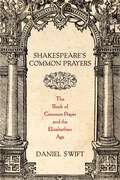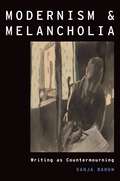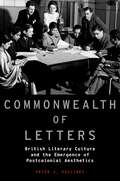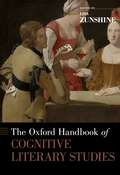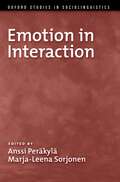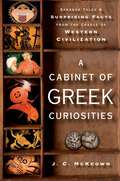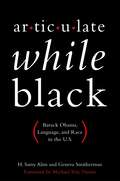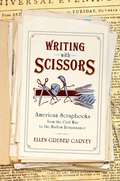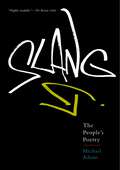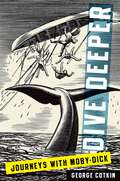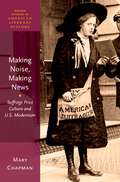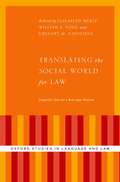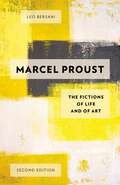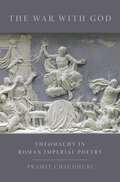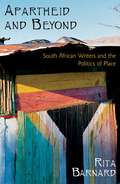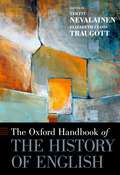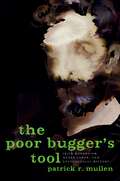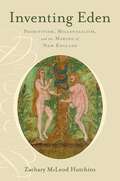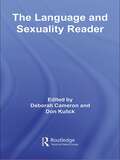- Table View
- List View
Shakespeare's Common Prayers: The Book of Common Prayer and the Elizabethan Age
by Daniel SwiftSocieties and entire nations draw their identities from certain founding documents, whether charters, declarations, or manifestos. The Book of Common Prayer figures as one of the most crucial in the history of the English-speaking peoples. First published in 1549 to make accessible the devotional language of the late Henry the VIII's new church, the prayer book was a work of monumental religious, political, and cultural importance. Within its rituals, prescriptions, proscriptions, and expressions were fought the religious wars of the age of Shakespeare. This diminutive book--continuously reformed and revised--was how that age defined itself. In Shakespeare's Common Prayers, Daniel Swift makes dazzling and original use of this foundational text, employing it as an entry-point into the works of England's most celebrated writer. Though commonly neglected as a source for Shakespeare's work, Swift persuasively and conclusively argues that the Book of Common Prayer was absolutely essential to the playwright. It was in the Book's ambiguities and its fierce contestations that Shakespeare found the ready elements of drama: dispute over words and their practical consequences, hope for sanctification tempered by fear of simple meaninglessness, and the demand for improvised performance as compensation for the failure of language to fulfill its promises. What emerges is nothing less than a portrait of Shakespeare at work: absorbing, manipulating, reforming, and struggling with the explosive chemistry of word and action that comprised early modern liturgy. Swift argues that the Book of Common Prayer mediates between the secular and the devotional, producing a tension that makes Shakespeare's plays so powerful and exceptional. Tracing the prayer book's lines and motions through As You Like It, Hamlet, Twelfth Night, Measure for Measure, Othello, and particularly Macbeth, Swift reveals how the greatest writer of the age--of perhaps any age--was influenced and guided by its most important book.
Shakespeare's Common Prayers: The Book of Common Prayer and the Elizabethan Age
by Daniel SwiftSocieties and entire nations draw their identities from certain founding documents, whether charters, declarations, or manifestos. The Book of Common Prayer figures as one of the most crucial in the history of the English-speaking peoples. First published in 1549 to make accessible the devotional language of the late Henry the VIII's new church, the prayer book was a work of monumental religious, political, and cultural importance. Within its rituals, prescriptions, proscriptions, and expressions were fought the religious wars of the age of Shakespeare. This diminutive book--continuously reformed and revised--was how that age defined itself. In Shakespeare's Common Prayers, Daniel Swift makes dazzling and original use of this foundational text, employing it as an entry-point into the works of England's most celebrated writer. Though commonly neglected as a source for Shakespeare's work, Swift persuasively and conclusively argues that the Book of Common Prayer was absolutely essential to the playwright. It was in the Book's ambiguities and its fierce contestations that Shakespeare found the ready elements of drama: dispute over words and their practical consequences, hope for sanctification tempered by fear of simple meaninglessness, and the demand for improvised performance as compensation for the failure of language to fulfill its promises. What emerges is nothing less than a portrait of Shakespeare at work: absorbing, manipulating, reforming, and struggling with the explosive chemistry of word and action that comprised early modern liturgy. Swift argues that the Book of Common Prayer mediates between the secular and the devotional, producing a tension that makes Shakespeare's plays so powerful and exceptional. Tracing the prayer book's lines and motions through As You Like It, Hamlet, Twelfth Night, Measure for Measure, Othello, and particularly Macbeth, Swift reveals how the greatest writer of the age--of perhaps any age--was influenced and guided by its most important book.
Modernism and Melancholia: Writing as Countermourning (Modernist Literature and Culture)
by Sanja BahunModernism and melancholia share an intellectual fate: being at once categories, conditions, discourses, modes of expression, and social projects, they feed on their own ambiguity. But modernism and melancholia also share a history: it was in the cultural-historical period we tentatively term "modernism" that a fundamental shift in our understanding of melancholia occurred. What is, then, the relationship between modernism and melancholia? How does it relate to the history of the late nineteenth and early twentieth century? What is the social value of the associated cluster of symbolic rituals that we call mourning? Modernism and Melancholia addresses these questions, as it focuses on the manifestations of melancholia in modernist fiction internationally. Paying close attention to writings by Andrei Bely, Franz Kafka, and Virginia Woolf, Sanja Bahun identifies in modernist fiction a deliberate use of the symptomatology of melancholia to reinvigorate the genre of the novel and address the complexities of contemporary history. Such an exercise establishes writing as a mourning ritual that self-consciously refuses to "heal" or "cure." To describe this paradoxical writing practice, Bahun proposes the term "countermourning." Reversing-or renewing-the ways in which the conceptual scope of melancholia is utilized in modernist studies, this study positions itself at the crossroads of literary studies and intellectual history, and suggests a continuity between the shifting view of melancholia in global modernism.
Commonwealth Of Letters Mlc C: British Literary Culture And The Emergence Of Postcolonial Aesthetics
by Peter J. KallineyCommonwealth of Letters: British Literary Culture and the Emergence of Postcolonial Aesthetics (Modernist Literature and Culture)
by Peter J. KallineyCommonwealth of Letters examines midcentury literary institutions integral to modernism and postcolonial writing. Several organizations central to interwar modernism, such as the BBC, influential publishers, and university English departments, became important sites in the emergence of postcolonial literature after the war. How did some of modernism's leading figures of the 1930s-such as T.S. Eliot, Louis MacNeice, and Stephen Spender-come to admire late colonial and early postcolonial literature in the 1950s? Similarly, why did late colonial and early postcolonial writers-including Chinua Achebe, Kamau Brathwaite, Claude McKay, and Ngugi wa Thiong'o-actively seek alliances with metropolitan intellectuals? Peter Kalliney's original and extensive archival work on modernist cultural institutions demonstrates that this disparate group of intellectuals had strong professional incentives to treat one another more as fellow literary professionals, and less as political or cultural antagonists. Surprisingly, metropolitan intellectuals and their late colonial counterparts leaned heavily on modernist theories of aesthetic autonomy to facilitate their collaborative ventures. For white, metropolitan writers, T.S. Eliot's notion of impersonality could help recruit new audiences and conspirators from colonized regions of the world. For black, colonial writers, aesthetic autonomy could be used to imagine a literary sphere uniquely resistant to the forms of racial prejudice endemic to the colonial system. This strategic collaboration did not last forever, but as Commonwealth of Letters shows, it left a lasting imprint on the ultimate disposition of modernism and the evolution of postcolonial literature.
The Oxford Handbook of Cognitive Literary Studies (Oxford Handbooks)
by Lisa ZunshineThe Oxford Handbook of Cognitive Literary Studies considers, via a variety of methodologies and combinations of interdisciplinary approaches, how the architecture that enables human cognitive processing interacts with cultural and historical contexts. Organized into five parts (Narrative, History, Imagination; Emotions and Empathy; The New Unconscious; Empirical and Qualitative Studies of Literature; and Cognitive Theory and Literary Experience), the volume uses case studies from a wide range of historical periods (from the fourth century BCE to the twenty-first century) and national literary traditions (including South Asian, postcolonial anglophone and francophone, Chinese, Japanese, English, Iranian, Russian, Italian, French, German, and Spanish).
Emotion in Interaction (Oxford Studies in Sociolinguistics)
by Anssi Peräkylä Marja-Leena SorjonenEmotion in Interaction offers a collection of original studies that explore emotion in naturally occurring spoken interaction.
A Cabinet of Greek Curiosities: Strange Tales and Surprising Facts from the Cradle of Western Civilization
by J. C. McKeownThe ancient Greeks were a wonderful people. They gave us democracy, drama, and philosophy, and many forms of art and branches of science would be inconceivable without their influence. And yet, they were capable of the most outlandish behavior, preposterous beliefs, and ludicrous opinions. Like its companion volume, A Cabinet of Roman Curiosities, this is an uproarious miscellany of odd stories and facts, culled from a lifetime of teaching ancient Greek civilization. In some ways, the book demonstrates how much the Greeks were like us. Politicians were regarded as shallow and self-serving; overweight people resorted to implausible diets; Socrates and the king of Sparta used to entertain their children by riding around on a stick pretending it was a horse. Of course, their differences from us are abundantly documented too and the book may leave readers with a few incredulous questions. To ward off evil, were scapegoats thrown down from cliffs, though fitted out with feathers and live birds to give them a sporting chance of survival? Did a werewolf really win the boxing event at the Olympic Games? Were prisoners released on bail so that they could enjoy dramatic festivals? Did anyone really believe that Pythagoras flew about on a magic arrow? Other such mysteries abound in this quirky and richly illustrated journey into the "glory that was Greece." "The loveliest thing on the black earth." Sappho of Lesbos "Well worth getting a copy." Pisistratus of Athens "Meticulously written, a must for every library." Ptolemy of Alexandria "Unputdownable." Atlas the Titan "Fantastic! Incredible!" Cassandra, priestess of Apollo "The ideal gift." Laocoon of Troy "Not too long." Callimachus of Cyrene "I find something new every time I dip in." Archimedes of Syracuse
A Cabinet of Greek Curiosities: Strange Tales and Surprising Facts from the Cradle of Western Civilization
by J. C. McKeownThe ancient Greeks were a wonderful people. They gave us democracy, drama, and philosophy, and many forms of art and branches of science would be inconceivable without their influence. And yet, they were capable of the most outlandish behavior, preposterous beliefs, and ludicrous opinions. Like its companion volume, A Cabinet of Roman Curiosities, this is an uproarious miscellany of odd stories and facts, culled from a lifetime of teaching ancient Greek civilization. In some ways, the book demonstrates how much the Greeks were like us. Politicians were regarded as shallow and self-serving; overweight people resorted to implausible diets; Socrates and the king of Sparta used to entertain their children by riding around on a stick pretending it was a horse. Of course, their differences from us are abundantly documented too and the book may leave readers with a few incredulous questions. To ward off evil, were scapegoats thrown down from cliffs, though fitted out with feathers and live birds to give them a sporting chance of survival? Did a werewolf really win the boxing event at the Olympic Games? Were prisoners released on bail so that they could enjoy dramatic festivals? Did anyone really believe that Pythagoras flew about on a magic arrow? Other such mysteries abound in this quirky and richly illustrated journey into the "glory that was Greece." "The loveliest thing on the black earth." Sappho of Lesbos "Well worth getting a copy." Pisistratus of Athens "Meticulously written, a must for every library." Ptolemy of Alexandria "Unputdownable." Atlas the Titan "Fantastic! Incredible!" Cassandra, priestess of Apollo "The ideal gift." Laocoon of Troy "Not too long." Callimachus of Cyrene "I find something new every time I dip in." Archimedes of Syracuse
Articulate While Black: Barack Obama, Language, and Race in the U.S.
by Geneva Smitherman H. Samy AlimBarack Obama is widely considered one of the most powerful and charismatic speakers of our age. Without missing a beat, he often moves between Washington insider talk and culturally Black ways of speaking--as shown in a famous YouTube clip, where Obama declined the change offered to him by a Black cashier in a Washington, D.C. restaurant with the phrase, "Nah, we straight." In Articulate While Black, two renowned scholars of Black Language address language and racial politics in the U.S. through an insightful examination of President Barack Obama's language use--and America's response to it. In this eloquently written and powerfully argued book, H. Samy Alim and Geneva Smitherman provide new insights about President Obama and the relationship between language and race in contemporary society. Throughout, they analyze several racially loaded, cultural-linguistic controversies involving the President--from his use of Black Language and his "articulateness" to his "Race Speech," the so-called "fist-bump," and his relationship to Hip Hop Culture. Using their analysis of Barack Obama as a point of departure, Alim and Smitherman reveal how major debates about language, race, and educational inequality erupt into moments of racial crisis in America. In challenging American ideas about language, race, education, and power, they help take the national dialogue on race to the next level. In much the same way that Cornel West revealed nearly two decades ago that "race matters," Alim and Smitherman in this groundbreaking book show how deeply "language matters" to the national conversation on race--and in our daily lives.
Writing with Scissors: American Scrapbooks from the Civil War to the Harlem Renaissance
by Ellen Gruber GarveyMen and women 150 years ago grappled with information overload by making scrapbooks-the ancestors of Google and blogging. From Abraham Lincoln to Susan B. Anthony, African American janitors to farmwomen, abolitionists to Confederates, people cut out and pasted down their reading. Writing with Scissors opens a new window into the feelings and thoughts of ordinary and extraordinary Americans. Like us, nineteenth-century readers spoke back to the media, and treasured what mattered to them. In this groundbreaking book, Ellen Gruber Garvey reveals a previously unexplored layer of American popular culture, where the proliferating cheap press touched the lives of activists and mourning parents, and all who yearned for a place in history. Scrapbook makers documented their feelings about momentous public events such as living through the Civil War, mediated through the newspapers. African Americans and women's rights activists collected, concentrated, and critiqued accounts from a press that they did not control to create "unwritten histories" in books they wrote with scissors. Whether scrapbook makers pasted their clippings into blank books, sermon collections, or the pre-gummed scrapbook that Mark Twain invented, they claimed ownership of their reading. They created their own democratic archives. Writing with Scissors argues that people have long had a strong personal relationship to media. Like newspaper editors who enthusiastically "scissorized" and reprinted attractive items from other newspapers, scrapbook makers passed their reading along to family and community. This book explains how their scrapbooks underlie our present-day ways of thinking about information, news, and what we do with it.
Slang: The People's Poetry
by Michael AdamsSlang, writes Michael Adams, is poetry on the down low, and sometimes lowdown poetry on the down low, but rarely, if ever, merely lowdown. It is the poetry of everyday speech, the people's poetry, and it deserves attention as language playing on the cusp of art. In Slang: The People's Poetry, Adams covers this perennially interesting subject in a serious but highly engaging way, illuminating the fundamental question "What is Slang" and defending slang--and all forms of nonstandard English--as integral parts of the American language. Why is an expression like "bed head" lost in a lexical limbo, found neither in slang nor standard dictionaries? Why are snow-boarding terms such as "fakie," "goofy foot," "ollie" and "nollie" not considered slang? As he addresses these and other lexical curiosities, Adams reveals that slang is used in part to define groups, distinguishing those who are "down with it" from those who are "out of it." Slang is also a rebellion against the mainstream. It often irritates those who color within the lines--indeed, slang is meant to irritate, sometimes even to shock. But slang is also inventive language, both fun to make and fun to use. Rather than complain about slang as "bad" language, Adams urges us to celebrate slang's playful resistance to the commonplace and to see it as the expression of an innate human capacity, not only for language, but for poetry.
Dive Deeper: Journeys with Moby-Dick
by George CotkinHerman Melville's epic tale of obsession has all the ingredients of a first rate drama--fascinating characters in solitude and society, battles between good and evil, a thrilling chase to the death--and yet its allusions, digressions, and sheer scope can prove daunting to even the most intrepid reader. George Cotkin's Dive Deeper provides both a guide to the novel and a record of its dazzling cultural train. It supplies easy-to-follow plot points for each of the novel's 135 sections before taking up a salient phrase, image, or idea in each for further exploration. Through these forays, Cotkin traces the astonishing reach of the novel, sighting the White Whale in mainstream and obscure subcultures alike, from impressionist painting circles to political terrorist cells. In a lively and engaging style, Dive Deeper immerses us into the depths of Melville's influence on the literature, film, and art of our modern world. Cotkin's playful wit and critical precision stretch from Camus to Led Zeppelin, from Emerson to Bob Dylan, and bring to life the terrors and wonders of what is arguably America's greatest novel.
Writing with Scissors: American Scrapbooks from the Civil War to the Harlem Renaissance
by Ellen Gruber GarveyMen and women 150 years ago grappled with information overload by making scrapbooks-the ancestors of Google and blogging. From Abraham Lincoln to Susan B. Anthony, African American janitors to farmwomen, abolitionists to Confederates, people cut out and pasted down their reading. Writing with Scissors opens a new window into the feelings and thoughts of ordinary and extraordinary Americans. Like us, nineteenth-century readers spoke back to the media, and treasured what mattered to them. In this groundbreaking book, Ellen Gruber Garvey reveals a previously unexplored layer of American popular culture, where the proliferating cheap press touched the lives of activists and mourning parents, and all who yearned for a place in history. Scrapbook makers documented their feelings about momentous public events such as living through the Civil War, mediated through the newspapers. African Americans and women's rights activists collected, concentrated, and critiqued accounts from a press that they did not control to create "unwritten histories" in books they wrote with scissors. Whether scrapbook makers pasted their clippings into blank books, sermon collections, or the pre-gummed scrapbook that Mark Twain invented, they claimed ownership of their reading. They created their own democratic archives. Writing with Scissors argues that people have long had a strong personal relationship to media. Like newspaper editors who enthusiastically "scissorized" and reprinted attractive items from other newspapers, scrapbook makers passed their reading along to family and community. This book explains how their scrapbooks underlie our present-day ways of thinking about information, news, and what we do with it.
Making Noise, Making News: Suffrage Print Culture and U.S. Modernism (Oxford Studies in American Literary History #6)
by Mary ChapmanFor most people, the U.S. suffrage campaign is encapsulated by images of iconic nineteenth-century orators like the tightly coifed Susan B. Anthony or the wimpled Elizabeth Cady Stanton. However, as Mary Chapman shows, the campaign to secure the vote for U.S. women was also a modern and print-cultural phenomenon, waged with humor, creativity, and style. Making Noise, Making News also understands modern suffragist print culture as a demonstrable link between the Progressive Era's political campaign for a voice in the public sphere and Modernism's aesthetic efforts to re-imagine literary voice. Chapman charts a relationship between modern suffragist print cultural "noise" and what literary modernists understood by "making it new," asserting that the experimental tactics of U.S. suffrage print culture contributed to, and even anticipated, the formal innovations of U.S. literary modernism. Drawing on little-known archives and featuring over twenty illustrations, Making Noise, Making News provides startling documentation of Marianne Moore's closeted career as a suffrage propagandist, the persuasive effects of Alice Duer Miller's popular poetry column, Asian-American author Sui Sin Far's challenge to the racism and classism of modern suffragism, and Gertrude Stein's midcentury acknowledgement of intersections between suffrage discourse and literary modernism.
Translating the Social World for Law: Linguistic Tools for a New Legal Realism (Oxford Studies in Language and Law)
by Elizabeth Mertz William K. Ford Gregory MatoesianThis volume examines the linguistic problems that arise in efforts to translate between law and the social sciences. We usually think of "translation" as pertaining to situations involving distinct languages such as English and Swahili. But realistically, we also know that there are many kinds of English or Swahili, so that some form of translation may still be needed even between two people who both speak English-including, for example, between English speakers who are members of different professions. Law and the social sciences certainly qualify as disciplines with quite distinctive language patterns and practices, as well as different orientations and goals. In coordinated papers that are grounded in empirical research, the volume contributors use careful linguistic analysis to understand how attempts to translate between different disciplines can misfire in systematic ways. Some contributors also point the way toward more fruitful translation practices. The contributors to this volume are members of an interdisciplinary working group on Legal Translation that met for a number of years. The group includes scholars from law, philosophy, anthropology, linguistics, political science, psychology, and religious studies. The members of this group approach interdisciplinary communication as a form of "translation" between distinct disciplinary languages (or, "registers"). Although it may seem obvious that professionals in different fields speak and think differently about the world, in fact experts in law and in social science too often assume that they can communicate easily when they are speaking what appears to be the "same" language. While such experts may intellectually understand that they differ regarding their fundamental assumptions and uses of language, they may nonetheless consistently underestimate the degree to which they are actually talking past one another. This problem takes on real-life significance when one of the fields is law, where how knowledge is conveyed can affect how justice is meted out.
Marcel Proust: The Fictions of Life and of Art
by Leo BersaniOxford University Press published eminent literary critic Leo Bersani's first book, on Proust, in 1965, but the work has long been out of print. This new edition comes in response to a recent renewal of interest among philosophers of literature, among others, and features a new preface from the author.
Apartheid and Beyond: South African Writers and the Politics of Place
by Rita BarnardApartheid and Beyond offers trenchant, historically sensitive readings of writings by Coetzee, Gordimer, Fugard, Tlali, Dike, Magona, and Mda, focusing on the intimate relationship between place, subjectivity, and literary form. It also explores the way apartheid functioned in its day-to-day operations as a geographical system of control, exerting its power through such spatial mechanisms as residential segregation, bantustans, passes, and prisons. Throughout the study, Rita Barnard provides historical context by highlighting key events such as colonial occupation, the creation of black townships, migration, forced removals, the emergence of informal settlements, and the gradual integration of white cities. Apartheid and Beyond is both an innovative account of an important body of politically inflected literature and an imaginative reflection on the socio-spatial aspects of the transition from apartheid to democracy.
The Oxford Handbook of the History of English: Studies Based On The Corpus Of Early English Correspondence (Oxford Handbooks #15)
by Terttu NevalainenThe availability of large electronic corpora has caused major shifts in linguistic research, including the ability to analyze much more data than ever before, and to perform micro-analyses of linguistic structures across languages. This has historical linguists to rethink many standard assumptions about language history, and methods and approaches that are relevant to the study of it. The field is now interested in, and attracts, specialists whose fields range from statistical modeling to acoustic phonetics. These changes have even transformed linguists' perceptions of the very processes of language change, particularly in English, the most studied language in historical linguistics due to the size of available data and its status as a global language. The Oxford Handbook of the History of English takes stock of recent advances in the study of the history of English, broadening and deepening the understanding of the field. It seeks to suggest ways to rethink the relationship of English's past with its present, and make transparent the variety of conditions and processes that have been instrumental in shaping that history. Setting a new standard of cross-theoretical collaboration, it covers the field in an innovative way, providing diachronic accounts of major influences such as language contact, and typological processes that have shaped English and its varieties, as well as highlighting recent and ongoing developments of Englishes--celebrating the vitality of language change over the centuries and the many contexts and processes through which language change occurs.
The Poor Bugger's Tool: Irish Modernism, Queer Labor, and Postcolonial History
by Patrick R. MullenWith the weakening moral authority of the Catholic Church, the boom ushered in by the Celtic Tiger, and the slow but steady diminishment of the Troubles in the North, Ireland has finally stepped out from the shadows of colonial oppression onto the world stage as a major cosmopolitan country. Taking its title from a veiled reference to Roger Casement-the humanitarian and Irish patriot hanged for treason-in James Joyce's Ulysses, The Poor Bugger's Tool demonstrates how the affective labor of Irish queer culture might contribute to a progressive new national image for the Republic and Northern Ireland. Looking back to the first wave of Irish modernism in the works of Wilde, Synge, Casement, and Joyce, Patrick Mullen reveals how these authors deployed queer aesthetics to shape inclusive forms of national affiliation as well as to sharpen anti-imperialist critiques. In its second half, the monograph turns its attention to Ireland's postmodernist boom in the works of Patrick McCabe, Neil Jordan, and Jamie O'Neill. With readings of The Butcher Boy, Breakfast on Pluto, and At Swim Two Boys, Mullen shows that queer sensibilities and style remain key cultural resources for negotiating the political and economic realities of globalization at the turn of the twenty-first century. Buttressed by writings of theorists like Marx, Foucault, and Antonio Negri, The Poor Bugger's Tool brings Irish literature into a fruitful dialog with queer theory, postcolonial studies, the history of sexuality, and modernist aesthetics.
Inventing Eden: Primitivism, Millennialism, and the Making of New England
by Zachary McLeod HutchinsPrevious scholars have noted the Puritans' edenic descriptions of New World landscapes, but Inventing Eden is the first study to fully uncover the integral relationship between the New England interest in paradise and the numerous iconic intellectual artifacts and social movements of colonial North America. Harvard Yard, the Bay Psalm Book, and the Quaker use of antiquated pronouns like thee and thou: these are products of a seventeenth-century desire for Eden. So, too, are the evangelical emphasis of the Great Awakening, the doctrine of natural law popularized by the Declaration of Independence, and the first United States judicial decision abolishing slavery. Be it public nudity or Freemasonry, Zachary Hutchins convincingly shows how a shared wish to bring paradise into the pragmatic details of colonial living had a profound effect on early New England life and its substantial culture of letters. Spanning two centuries and surveying the works of major British and American thinkers from James Harrington and John Milton to Anne Hutchinson and Benjamin Franklin, Inventing Eden is the history of an idea that irrevocably altered the theology, literature, and culture of colonial New England -- and, eventually, the new republic.
Title Updated: Genes, Race, And History (Object Lessons)
by Kati StevensObject Lessons is a series of short, beautifully designed books about the hidden lives of ordinary things. The electric candle and faux fur, coffee substitutes and meat analogues, Obama impersonators, prosthetics. Imitation this, false that. Humans have been replacing and improving upon the real thing for millennia – from wooden toes found on Egyptian mummies to the Luxor pyramid in Las Vegas. So why do people have such disdain for so-called “fakes”? Kati Stevens's Fake discusses the strange history of imitations, as well as our ever-changing psychological and socioeconomic relationships with them. After all, fakes aren't going anywhere; they seem to be going everywhere. Object Lessons is published in partnership with an essay series in The Atlantic.
